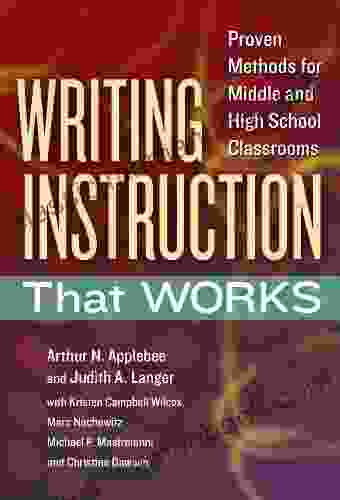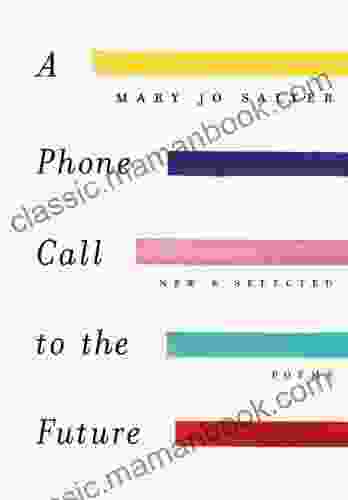Writing Instruction That Works: A Comprehensive Guide to Effective Writing Pedagogy

4.2 out of 5
| Language | : | English |
| File size | : | 2970 KB |
| Text-to-Speech | : | Enabled |
| Screen Reader | : | Supported |
| Enhanced typesetting | : | Enabled |
| Word Wise | : | Enabled |
| Print length | : | 224 pages |
Writing is a fundamental skill that empowers individuals to communicate effectively, express themselves creatively, and engage with the world around them. As educators, we have the responsibility to foster the development of strong writing abilities in our students. Effective writing instruction is not merely about teaching students to write grammatically correct sentences; it encompasses a holistic approach that nurtures their creativity, critical thinking, and ability to convey ideas clearly and persuasively.
Research-Based Strategies for Writing Instruction
Over the years, extensive research has been conducted to identify the most effective strategies for teaching writing. Here are some research-backed techniques that can help educators improve their writing instruction:
1. Process Writing
Process writing emphasizes the iterative nature of writing and encourages students to engage in multiple drafts and revisions. Through this approach, students develop a deeper understanding of the writing process and learn to produce more polished and thoughtful pieces. Teachers can guide students through the process by providing structured scaffolds and feedback at each stage.
2. Writer's Workshop
The writer's workshop model creates a supportive and collaborative learning environment where students can share their writing, receive feedback, and learn from their peers. This interactive approach fosters a sense of community and encourages students to take ownership of their writing.
3. Genre-Based Instruction
Genre-based instruction focuses on teaching writing in the context of specific genres, such as narratives, essays, or poetry. By studying the conventions and structures of different genres, students develop a deeper understanding of how to write effectively for various purposes and audiences.
4. Technology Integration
Technology can be a powerful tool for enhancing writing instruction. Digital writing tools, such as word processors and collaborative platforms, allow students to experiment with different writing styles, receive real-time feedback, and share their work with others.
Best Practices for Effective Writing Instruction
In addition to research-based strategies, there are several best practices that educators can adopt to create a conducive learning environment for writing:
1. Establish Clear Learning Objectives
Start by clearly outlining the specific learning objectives for each writing assignment. This will provide students with a clear understanding of what is expected of them and help them stay focused throughout the writing process.
2. Provide Explicit Instruction
Don't assume that students know how to write effectively. Provide explicit instruction on the writing process, grammar, and vocabulary. Use clear and concise language, and provide examples and non-examples to illustrate key concepts.
3. Offer Regular Feedback
Regular feedback is essential for student growth. Provide students with specific and constructive criticism on their writing. Focus on both strengths and areas for improvement, and help students develop strategies for self-assessment.
4. Encourage Revision and Editing
Revision and editing are crucial steps in the writing process. Encourage students to revisit their writing multiple times and make necessary revisions and edits to improve clarity, coherence, and style.
5. Create a Positive and Supportive Learning Environment
Students are more likely to succeed in writing when they feel supported and encouraged. Create a positive and respectful learning environment where students feel comfortable sharing their ideas and taking risks in their writing.
Writing Curriculum Development
Effective writing instruction requires a well-structured curriculum that aligns with the learning objectives and provides a progressive learning experience. Here are some considerations for developing a writing curriculum:
1. Grade-Level Appropriateness
The writing curriculum should be tailored to the specific grade level and students' developmental needs. Start with foundational skills in the early grades and gradually introduce more complex concepts and writing tasks as students progress.
2. Purposeful Writing
Incorporate purposeful writing tasks that encourage students to write for real-world audiences and purposes. This can include writing letters, essays, articles, or creative stories.
3. Differentiation
Recognize that students have varying writing abilities and needs. Differentiate instruction by providing differentiated assignments, scaffolding, and support to ensure that all students can succeed.
4. Assessment and Evaluation
Regular assessment is necessary to monitor student progress and provide feedback. Use a variety of assessment methods, such as writing portfolios, rubrics, and self-reflections, to evaluate students' writing skills and provide guidance for further development.
Writing instruction is a complex and multifaceted endeavor, but with the right strategies and best practices, educators can empower students to become confident and proficient writers. By embracing research-based approaches, creating a supportive learning environment, and developing a comprehensive curriculum, educators can foster a lifelong love of writing in their students.
Remember, effective writing instruction is an ongoing journey that requires continuous reflection and adaptation to meet the evolving needs of students. As educators, we have a responsibility to stay abreast of the latest research and pedagogical practices to ensure that our students receive the best possible writing education.
4.2 out of 5
| Language | : | English |
| File size | : | 2970 KB |
| Text-to-Speech | : | Enabled |
| Screen Reader | : | Supported |
| Enhanced typesetting | : | Enabled |
| Word Wise | : | Enabled |
| Print length | : | 224 pages |
Do you want to contribute by writing guest posts on this blog?
Please contact us and send us a resume of previous articles that you have written.
 Top Book
Top Book Novel
Novel Fiction
Fiction Nonfiction
Nonfiction Literature
Literature Paperback
Paperback Hardcover
Hardcover E-book
E-book Audiobook
Audiobook Bestseller
Bestseller Classic
Classic Mystery
Mystery Thriller
Thriller Romance
Romance Fantasy
Fantasy Science Fiction
Science Fiction Biography
Biography Memoir
Memoir Autobiography
Autobiography Poetry
Poetry Drama
Drama Historical Fiction
Historical Fiction Self-help
Self-help Young Adult
Young Adult Childrens Books
Childrens Books Graphic Novel
Graphic Novel Anthology
Anthology Series
Series Encyclopedia
Encyclopedia Reference
Reference Guidebook
Guidebook Textbook
Textbook Workbook
Workbook Journal
Journal Diary
Diary Manuscript
Manuscript Folio
Folio Pulp Fiction
Pulp Fiction Short Stories
Short Stories Fairy Tales
Fairy Tales Fables
Fables Mythology
Mythology Philosophy
Philosophy Religion
Religion Spirituality
Spirituality Essays
Essays Critique
Critique Commentary
Commentary Glossary
Glossary Bibliography
Bibliography Index
Index Table of Contents
Table of Contents Preface
Preface Introduction
Introduction Foreword
Foreword Afterword
Afterword Appendices
Appendices Annotations
Annotations Footnotes
Footnotes Epilogue
Epilogue Prologue
Prologue Sara Joy Warne
Sara Joy Warne Julie Mcdonald
Julie Mcdonald Ashley Audrain
Ashley Audrain Norman Maccaig
Norman Maccaig Imelda May
Imelda May Arrl Inc
Arrl Inc Appearance Publishers
Appearance Publishers Kenneth Rexroth
Kenneth Rexroth Rachel Hanna
Rachel Hanna C H Sisson
C H Sisson Jimmy Palmiotti
Jimmy Palmiotti Julia B Kingsley
Julia B Kingsley Rich Hites
Rich Hites Chris Wraight
Chris Wraight Justin Fenton
Justin Fenton Marcus Engel
Marcus Engel Charles Gounod
Charles Gounod M Ruth Myers
M Ruth Myers Damian Dibben
Damian Dibben Wayne Rohde
Wayne Rohde
Light bulbAdvertise smarter! Our strategic ad space ensures maximum exposure. Reserve your spot today!

 Frank MitchellThe Sales Fix Formula: The Ultimate Guide to Increasing Sales and Achieving...
Frank MitchellThe Sales Fix Formula: The Ultimate Guide to Increasing Sales and Achieving... Fernando BellFollow ·19.5k
Fernando BellFollow ·19.5k Mikhail BulgakovFollow ·18.2k
Mikhail BulgakovFollow ·18.2k Darren NelsonFollow ·13.6k
Darren NelsonFollow ·13.6k Henry Wadsworth LongfellowFollow ·3.7k
Henry Wadsworth LongfellowFollow ·3.7k Cade SimmonsFollow ·3.5k
Cade SimmonsFollow ·3.5k Francisco CoxFollow ·7.5k
Francisco CoxFollow ·7.5k Hank MitchellFollow ·8.8k
Hank MitchellFollow ·8.8k Donald WardFollow ·17.9k
Donald WardFollow ·17.9k
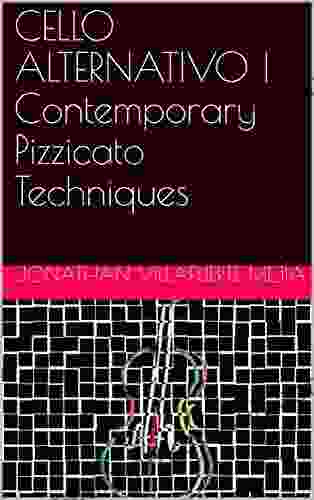
 Bryan Gray
Bryan GrayCello Alternativo: Exploring Contemporary Pizzicato...
: Embracing the Avant-Garde Within...
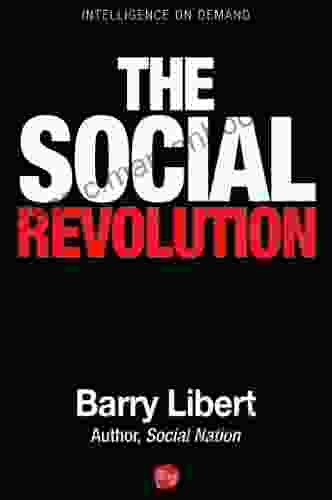
 Victor Hugo
Victor HugoThe Social Revolution: Barry Libert's Vision for a More...
In a world where...

 Tony Carter
Tony CarterA Comprehensive Guide to Crafting Clear and Effective Job...
A job description is a critical tool...
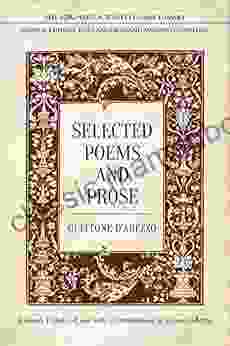
 Deacon Bell
Deacon BellSelected Poems And Prose Lorenzo Da Ponte Italian Library
Lorenzo Da Ponte, born...

 Francisco Cox
Francisco CoxWhat You Need To Know About Opportunity Cost: A...
Opportunity cost is a fundamental concept...

 Bill Grant
Bill GrantWhy Our Kids With Behavioral Challenges Are Falling...
Every year,...
4.2 out of 5
| Language | : | English |
| File size | : | 2970 KB |
| Text-to-Speech | : | Enabled |
| Screen Reader | : | Supported |
| Enhanced typesetting | : | Enabled |
| Word Wise | : | Enabled |
| Print length | : | 224 pages |


